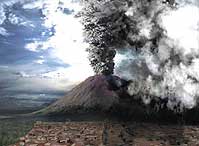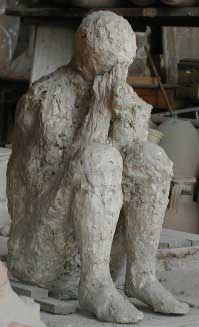The mystery of the destruction of Pompeii citadel
Pompeii is an ancient city with a long history, located in the south-west of Italy, at the foot of Vesuvius volcano.

Vesuvius Volcano
According to history books, Pompeii was built by 10 large tribes with the name Aus. By 79, this place had become the club of the rich. The nobility of wealthy merchants pulled together to find pleasure, so Pompeii became a Capital of Excellence.
Vesuvius volcano is an active volcano. By the beginning of the AD, the famous geologist Strabo based on the pattern of the land Vesuvius determined that the volcano had stopped working. The people of Pompeii at that time completely believed in the reasoning, Strabo's judgment was very safe to live at the foot of Vesuvius volcano. On the flanks of the volcano, people planted green fields, where they found lemon trees, kumquat and other trees like grapes . They did not expect the "dead volcano" to remain is preparing to cause a great destruction.

Images of dead people holding their faces
In 62, there was a powerful earthquake that devastated Pompeii city, many buildings were ruined. The architectural ruins seen today in Pompeii are the result of this earthquake. After the earthquake, the Pompeii continue to rebuild the city, even they want to build a more glamorous city.
But the city of Pompeii has not recovered yet, on August 24, 79, Vesuvius volcano suddenly lava. Back then Pompeii city had 25 thousand people. Although most escaped, there were still more than 2,000 people buried under ash and volcanic lava. After the volcano ceased, some survivors returned to the ancient citadel at the foot of Mount Vesuvius to search for properties when they could not run; but they didn't find anything. Along with the flow of time, people gradually forgot the city of Pompeii and the city also disappeared from there.
In 1594, a farmer built a canal on ancient Pompeii in the past, accidentally discovered a large piece of broken marble and stone money. In 1689, a man in a suburb of Naples while digging a well picked up a few pieces of carved stone, including a piece carved with the name Pompeii. Based on the findings, people predicted that Pompeii was built in this area.

Photos of dead people buried
In 1748, local farmers continued to find some relics in the ancient Pompeii ruins. And archaeologists' search for ancient Pompeii began.
Under the pile of volcanic ash in the red palm tree, a magical painting was discovered and excavated the first remains, beside falling some ancient gold coins and money. From the trace left on the ground can be speculated that this person is hurriedly picking up the falling gold coins unfortunately falling dead.
In 1763, John Winckeman - the German (1717-1768), served as the general supervisor of the objects in Rome and the surrounding area. With this position, John Winckeman visited Vesuvius and Herculaneun. He was very high on the objects found in the ancient city of Pompeii. He also left to correct the order of lost objects, sketching out Pompeii's historical figure.

Photos of dead people buried
In 1808 - 1815, the French scholar directed the excavation of the dead city of Pompeii. But it was not until 1860 that people began to conduct systematic excavations. In 1890, archaeologist Usepi - Fuaurouli officially put excavation work into operation. He has studied new excavation techniques to help buried people, animals, household appliances and wooden structures to be recreated with their existing capital. Visitors can see hundreds of postures of the victim before dying: Hands clasping human heads are curled into a lump; or hands with their heads down on the ground; or clutching the money bag and running in panic; or the mother holding the child dies; or the slaves who tried to break the lock but could not, so when they were still dead, they were still in chains . This was a terrible tragedy. In the rich flower palace, the room was being renovated, when both the owner and the carpenters who ran into the hallway were killed. Another mansion in the suburbs, the master and twenty slaves when they met in the same time were killed while hiding in an underground tunnel.
Up to now, Pompeii citadel has only 3/5 excavated areas. Like Herculaneun, there are still many victims and tools buried deep in the rubble in the ground. But the ancient splendor of the ancient Pompeii was also quite clearly laid out.

Panorama of Pompeii ancient city
Pompeii citadel has an area of 1.8km2. The walls were built of stone, the walls were 4.8 km long and had 7 gates with 14 majestic towers; 4 large streets cut across rocks, forming 9 areas. Each area has a small and large street connected, in the big street, it still keeps track of iron carts very deep on the road like a carriage just passed.

Stadium
At the crossroads of big streets, there are stone water machines of nearly 1m high, about 2m long to supply water to the towns. The water trough connected to the water tower is led from the water source of a high mountain outside the city with a hanging stone machine. Later, these water towers distributed water to public gutters at intersections. The fountain and fishponds of noble families and wealthy merchants also rely on this water supply system.
Pompeii people also built two theaters. The largest theater in the southeast of the city was built in 70 BC, with a capacity of 2, 000 people. This theater is also used as a stadium for wrestling between people and people with beasts.

Theater
On the East side of the big theater there is a sports field, each about 130 meters long. This sports ground is very magnificent, with a swimming pool in the middle. As expected, the yard can accommodate more than ten thousand people and it is also possible to regularly take place the economic, political and religious activities of the entire city of Pompeii.
The southwest of the city has a rectangular square, surrounding the building of a mansion, a court, a temple and a market.
There are at least 3 public bathrooms including hot and cold bathrooms, saunas and make-up rooms. On the walls the bathrooms are decorated with stone frescoes and sculptures.

Lecherous scenes painted on the pub's wall
Pompeii ancient ruins fully reflect the moral decadence of ancient Roman society. At that time, there was a part of people who were immersed in alcoholism with the corrupt and lustful lifestyle, extravagant and wasteful. But in Pompeii city there are lots of institutes and pubs. On the walls the museums were full of lewd scenes. Stalls with wine stalls and wine bars are located at the entrance so visitors can stand outside and still drink alcohol. On the walls, a number of wine stalls also saved the scribbles written and erased by the handlers. So far, those words are still vaguely distinguishable.
Because of Pompeii's preservation of precious materials and the whole face of social life in ancient Rome, it became a rare natural history museum in the world.
- Explain the mystery of the ancient tombs in Pompeii
- The mystery of the destruction of the ancient Indian citadel
- Recreate Pompeii historical disaster
- Discovered the ancient citadel from the 4th century in Quang Nam
- Continue to decipher the mystery at Ho Citadel
- The source of Pompeii style artefacts
- The incredible truth about couples hugging each other under the ashes 2,000 years ago
- Discover new archeology under Co Loa citadel
- Admire the world's oldest citadel
- Decoding Pompeii China
- The diet of 'sea breeze' of ancient Romans
- 'Pompeii' 300 million years in Asia
 The truth about the mysterious red-haired giant at Lovelock Cave
The truth about the mysterious red-haired giant at Lovelock Cave Inunaki Tunnel: The haunted road leading into Japan's 'village of death'
Inunaki Tunnel: The haunted road leading into Japan's 'village of death' The mystery of the phenomenon of human reflection before dying
The mystery of the phenomenon of human reflection before dying 6 mysterious phenomena, although science has been developed for a long time, still cannot be answered
6 mysterious phenomena, although science has been developed for a long time, still cannot be answered The Mystery of Pompeii Worms - The Bizarre Creature That Even Lava Can't Kill!
The Mystery of Pompeii Worms - The Bizarre Creature That Even Lava Can't Kill!  Discovered frescoes of Trojan mythological characters in Pompeii
Discovered frescoes of Trojan mythological characters in Pompeii  'The Most Unusual Treasure' Discovered in a 2,000-Year-Old Roman City
'The Most Unusual Treasure' Discovered in a 2,000-Year-Old Roman City  The 2,000-year-old creature intact and stunned in the petrified city
The 2,000-year-old creature intact and stunned in the petrified city  Decoding the 'petrified man' gene for the first time: The secret of the 'timeless' city
Decoding the 'petrified man' gene for the first time: The secret of the 'timeless' city  Ancient Italian city 'recruits' dog robots to fight poachers
Ancient Italian city 'recruits' dog robots to fight poachers 